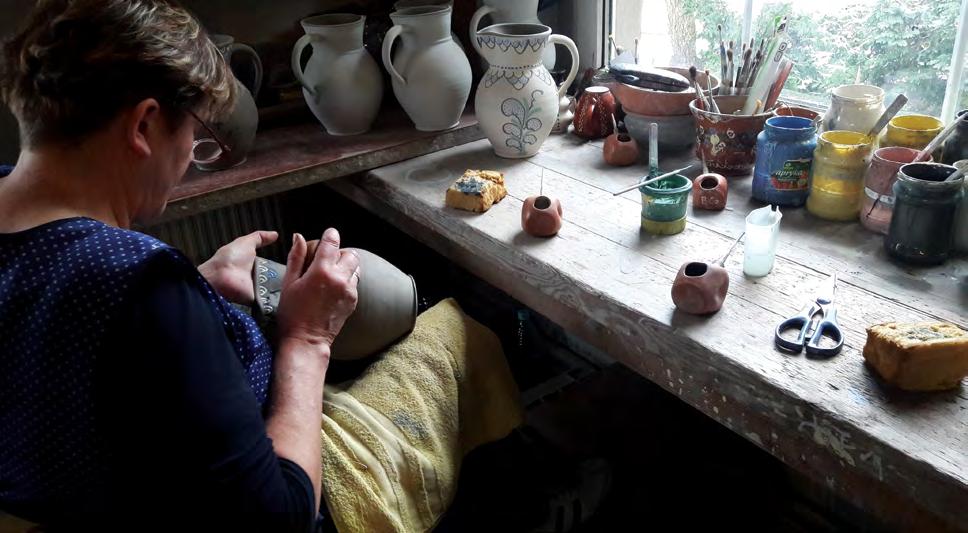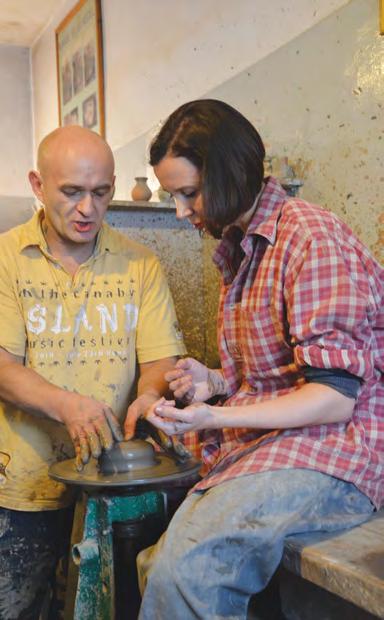
5 minute read
Sulislawa Borovska How and why should we build/animate local events/cultural initiatives?
HOW AND WHY SHOULD WE BUILD/ANIMATE
In November 2016, during our training visit we saw how various cultural initiatives can cater to the interests of different social groups in Kashubian region. «Our work follows from the need of an activity which is different from the daily routine associated with work and family. This gives us great satisfaction and a sense of fulfillment in life» says Sulislawa Borovska, project manager and cultural animator from Kashubian People’s University.
Advertisement
LOCAL EVENTS/CULTURAL INITIATIVES?
KASHUBIAN PEOPLE’S UNIVERSITY is the NGO (Foundation) registered in the National Court Register as a public educational institution, included in the Register of Kartusy County. Since 1982 Kashubian People’s University (KUL) continuously implements the mission of building a conscious civil society and continuous development of the region. Some of the KUL’s objectives are: continuous training for education and culture workers, scientific symposiums, courses that give farmers new professional competences, personal development workshops, courses of the Kashubian language, workshops on handicrafts, open-airs for the folk artists.
Sulislawa understands that the residents of Kashubian region need a space for the exchange of ideas, experience in animating activities/cultural initiatives. She knows how to do it and with whom. So we invited Sulislawa to the Festival of Cultural and Educational Initiatives in December to conduct master classes. Here are some practical tips from the experienced cultural animator.
«Cultural Animation» sometimes is associated with cartoons. But in the civic sector this trend has been used for a long time. First of all it is needed to vitalize a community and develop it.
How do we do it?
We organize events according to our own interests but also keeping in mind the community we live in.
We think how to engage the community in the activities.
The minimum plan is to involve residents in the proposed events, an invitation to watch, to share in the experience.
We also organize initiatives that foster cooperation already at the stage of preparation and then the implementation of our activity.
How do we engage the community to participate?
While planning future mass events we need to prepare the «scenarios» of satisfying personal interests of various participants. For example we ask ourselves: «What can a representative of a target group do to feel involved? If I am one of them, what should happen to make me desire to be included in the organization of this event?»
Librarian:
• the ability to implement projects; stands; • must be convinced in the need of cultural values; • free the book; • ability to present the library’s work and to organize events connected with reading
Fireman:
• security; • self-presentation • list of co-organizers; • demonstration of skill, equipment; • competition; • invitation to cooperation or initiator; • interesting rewards Mother with children (farther with children):
• introducing children; • possibility to show herself, her children’s performance; • time; • adaptation; • something interesting for the kids so that the mother can rest
Pensioner:
• nothing to do, so I will come; • possibility to introduce themselves / give a performance, show; • if a group where they work has an opportunity to perform / show themselves / share experiences; • feel needed / baking, talents; • staying healthy; • grandchildren performances Teacher:
• an event co-organized by the school; • a possibility of introducing students (artistic skills); • advancement; • is a community activist; • team performances; • a possibility to showcase one's achievements
Farmer:
• money; • they should ask me, preferably the village mayor; • benefits; • other farmers also join; • his wife from the Club of rural housewives will advise him; • the program meets expectations; • the organizer is an authority for the farmer; • presentation of agricultural machinery
Sulislawa Borovska
Залученість місцевого середовища вдається з трьох причин:
1. Намагаємось робити нашу діяльність максимально міждисциплінарною.
Якщо організовуємо змагання на байдарках, то до їх програми включаємо також ігри для дітей, навчання з надання першої допомоги, турнір пляжного волейболу, виставку фотографій, концерт, танці тощо. Серед учасників події з`являються не тільки любителі водних видів спорту.
2. Скеровуємо свої заходи безпосередньо на місцеву громаду.
Якщо робимо фільм про традиції та обряди нашого регіону, то до розповідей про них запрошуємо жителів старшого віку, організовуємо інсценізації за участі акторів-аматорів, які походять з цих країв. Під час показів серед громадськості є багато людей, залучених до створення фільму, які запрошують своїх близьких.
3. Підтримуємо ЛІДЕРа / AНІМАТОРа. Для чого? • Без лідера / aніматорa нeмає діяльності • Лідер асоціюється з місцем • Без захоплення / «серця» – нічого не вийде • СЕРЦЕ І ДУША – рушійна сила • Лідер – медіум, щоб «відчути» атмосферу конкретного місця/середовищa, через нього розкриваються ціннісні речі • Лідер приносить задоволення • Вчить • Приймає виклики • Вносить щось нове • Змушує мислити • Розвиток / творення спільної відповідальності
Культурно-освітня діяльність КНУ розширює уявлення учасників освітнього візиту про роботу одного з чотирьох Народних університетів Польщі. В КНУ запроваджено комплексну модель «помешкання для навчання і проживання». Під час презентацій особливий наголос робили на важливості тренінгів із саморозвитку людини, просування ідеї освіти дорослих через партиципаторні культурні практики.
Усі учасники освітнього візиту мали можливість попрактикуватись у розписі кераміки під керівництвом Аґнєшки Шульфер, вивчити стиль кашубських орнаментів на парцеляні, попрацювати із глиною та наблизитися до історії давніх ремесел.
1
2
На фото: 1. Олена Танасійчук бере участь у майстер-класі з гончарства.
2. Чашки з традиційним кашубським орнаментом, які розписали учасники візиту.
The involvement of the local community is possible for three reasons:
1.We try to make our activities as interdisciplinary as possible.
If we organize a kayak competition, it also includes games for children, first aid training, beach volleyball tournament, an exhibition of photographs, a concert, a disco etc. So not only water sports enthusiasts show up for the event.
2. We focus our actions on the local community.
If we make a film about the traditions and rituals of the region, we invite older residents to tell about them, invite amateur actors from this region for enactments. There are many people involved in making the film and they invite their relatives and friends.
3. We support the leader/animator. Why?
• There is no activity without a leader/animator • A leader is associated with the place • It does not work without enthusiasm / «heart» • Heart and soul is the driving force • Leader, a medium, has to «feel» the atmosphere of the place because it reveals value-based things • Leader brings pleasure • Teaches • Accepts challenges • Introduces something new • Encourages thinking • Development / creation of shared responsibility








